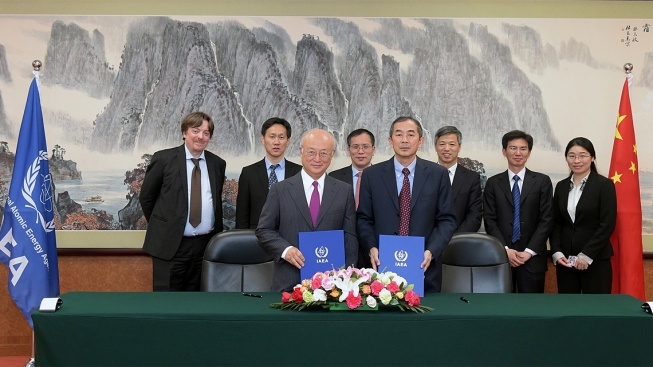
IAEA Director General and Wang Yiren, Acting Chairman of the China Atomic Energy Authority (CAEA), signed a transit agreement last week for the transport of low enriched uranium (LEU) in support of the IAEA LEU Bank. LEU is the basic ingredient used to fabricate the fuel that runs most nuclear power reactors in the world.
Under the agreement, China will ensure the safe and secure transit of LEU and equipment through Chinese territory to and from the IAEA LEU Bank, which is being established in neighbouring Kazakhstan. The IAEA LEU Bank will host a physical reserve of LEU, acting as a supplier of last resort for Member States in case they cannot acquire LEU from the commercial market or by any other means.
“The agreement with China is a milestone that will help bring the IAEA LEU Bank into operation,” Mr Amano said following the signature of the agreement on 5 April in Beijing.
Mr Amano also visited China’s Centre of Excellence for Nuclear Security, opened last year, which he described as “advanced and comprehensive”. The Centre is already training Chinese nationals, as well as professionals from other countries, in a broad range of nuclear security activities — including physical protection measures, nuclear forensics, and frontline training for police and security guards. Mr Amano noted the important role the Centre was playing in strengthening nuclear security in the region and beyond, and looked forward to further collaboration between the Centre and the IAEA in this area in the future.
During his three-day visit to China, Mr Amano met Chinese Vice Premier Ma Kai and Deputy Foreign Minister Li Baodong.
Discussions between Mr Amano and his hosts centred around the development of nuclear power in China and globally, and the importance of strengthening nuclear safety and security both regionally and around the world.
“China is one of the main centres of nuclear development globally,” Mr Amano said. “You have the technology, you have the funds, you have very capable people.” China has 20 nuclear power reactors under construction, more than any other country, as well as 36 in operation.
Mr Amano visited the Shanghai Nuclear Engineering Research and Design Institute, as well as the major components manufacturing site of the Shanghai Electric Company, which are involved in key projects such as the development and construction of the CAP1400 nuclear power plant, and the high temperature gas-cooled reactor project in China, a project currently under construction at Shidaowan, 800 km southeast of Beijing.
The gas-cooled reactor project, which is expected to be completed by 2018, will be the first advanced small modular reactor (SMR) installation in the world. SMRs are an option for flexible and affordable power generation. Deployable either as single or multi-module plant, SMRs offer the possibility to combine nuclear with alternative energy sources, including renewables.
https://www.iaea.org/node/30337
